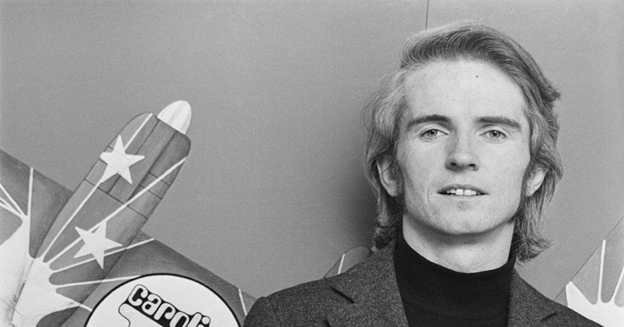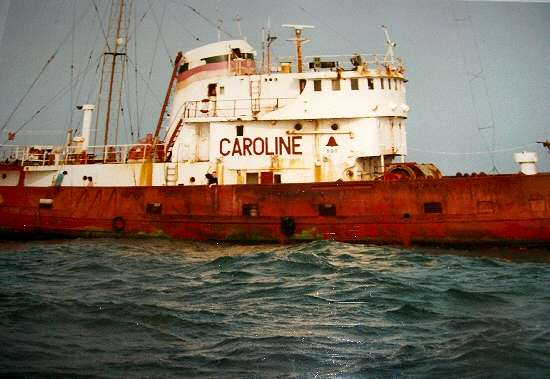SAIL down memory lane… Get inspired by the man behind the ship that caused a thousand (sound) waves! [Fridays: Gorillas of Guerrilla Marketing]

What are some of the things that you can hear from the radio?
News?
Radio drama?
Songs?
Back in the 1960s in the UK (United Kingdom), people were used to having and listening to just one supreme radio station around―the British Broadcasting Corporation (BBC).
No one dared to challenge the monopoly.
Until…
A pirate radio station emerged.
Pirate radio station – A radio station that broadcasts without a valid license. It could be because a radio signal crosses a national boundary, or due to the nature of a radio station’s content, transmission format, and transmit power (wattage).
Pirate radio stations started at the onset of airwave regulation, when radio was still in its early stages of development.
In the UK, the term did not only refer to an unauthorized use of a state-owned radio frequency but also the nature of “offshore” radio stations that operated on ships or marine platforms.
Are you curious as to who pioneered the idea of pirate radio stations?
It’s none other than “rebel rock broadcaster” Ronan O’Rahilly!

O’Rahilly was an Irish businessman who is best known for the creation of the pirate radio station Radio Caroline. He was also the manager of George Lazenby, the Australian actor who portrayed the role of James Bond in one film.
The ship that launched a thousand “hits.”
It was in the year 1964 when the sound of pop music was changing in the UK. People are starting to welcome new genres and different artists. However, listening to hit songs on the radio was another matter, since pop music was only played an hour per week by the BBC through its Saturday morning’s Light Programme.
During that time, Radio Luxembourg, which was located in the Grand Duchy of Luxembourg, was the only refuge for those who were seeking revolutionary new music.
Influenced by the radio station’s strategy as well as other offshore radio stations in Scandinavia and the Netherlands, O’Rahilly launched his own radio station (Radio Caroline) outside British territorial waters after buying a disused Danish ferry for GBP 20,000, or about GBP 350,000 in today’s currency. That’s translated to roughly USD 450,000 today.

As a manager of some musical artists, part of O’Rahilly’s decision to create Radio Caroline was his frustration at how difficult it was to get his artists an airplay on official radio stations, since those stations only accepted established artists and musicians―like Frank Sinatra and Perry Como.
The pirate radio station began broadcasting on March 28, 1964 with a pre-recorded message from presenters Chris Moore and Simon Dee announcing:
“This is Radio Caroline on 199―your all-day music station.”
As opposed to BBC’s pop music broadcasting of only an hour per week, Radio Caroline broadcasted from 6 AM to 6 PM EVERY DAY of the week.
It was only a matter of time when the pirate radio station attracted millions of listeners, especially teenagers and “postwar boom babies.”
The first track that was played by O’Rahilly’s radio station was rock band The Rolling Stones’ version of the song, “Not Fade Away,” with the opening line, “I’m gonna tell you how it’s gonna be.”
This opening line was O’Rahilly’s first shot at the BBC bosses, challenging them and their radio monopoly to eventually “get with it.”
English disc jockey Tony Blackburn was Radio Caroline’s youngest DJ at that time and the radio station’s presenters included Johnny Walker, Tommy Vance, Dave Lee Travis, Keith Skues, Spangles Muldoon, Robbie Dale, and Tony Prince.
A small cabin with only one porthole served as their studio in the ship.
RESULTS
O’Rahilly’s Radio Caroline became famous that musical group The Fortunes recorded the pirate radio’s theme song, and a Radio Caroline t-shirt became the latest fashion fad during those years.

Aside from that, teenage girls would even travel out in sailboats just to see the ship up close and wave to the presenters on board.
Through Radio Caroline, O’Rahilly drew an audience of 25 million in his prime and was credited with helping spark the “Swinging 60s,” the youth-driven cultural revolution in the UK during the 1960s.
O’Rahilly was also acknowledged by London-based daily national newspaper The Times as “the godfather of the pirate radio stations which revolutionized British broadcasting in the 1960s.”
Lastly, the success of Radio Caroline led to BBC’s launch of Radio 1, Britain’s first legal pop music station in 1967.
Today’s article may seem like a bit of a trip back in time to discuss history, but as a business owner or marketer, what can you learn from O’Rahilly and Radio Caroline?
-
T-shirts. This type of marketing collateral is a classic idea!
T-shirts are one way for people to get to know your brand. Think of all the people you’ll come across as you travel from place to place while wearing your “branded” shirt. If your shirt is attention-grabbing, people will definitely notice it and check out your brand.
You can print on both the front and the back of the shirt. Just make sure that the prints are not “overly designed” to the point that people who see it will get disgusted instead of interested.
Think of the Radio Caroline shirt. The design was simple and just had the logo but it became the fashion trend in the Swinging 60s. A lot of people wore it everywhere no matter what the occasion was.
Through the shirts, O’Rahilly and his crew were effortlessly getting their radio station promoted anytime, anywhere.
-
Cross Promotion. As mentioned earlier in this article, Radio Caroline’s theme song was recorded by The Fortunes.
Just like the pirate radio station, you can also enlist bands or other influencers to advertise your brand in their own channels.
It’s a good sign if they have a huge following. That means your brand can get exposed to a lot more people who could eventually be one of your loyal customers someday too!
-
Use the right platform. Thanks to the digital era, there are now a lot of platforms where you can promote your business―social media, TV, email, etc.
In the case of Radio Caroline, it was using radio as a platform to promote rising artists and new music.
As a radio station, its transmission signal had the capacity to reach thousands (even millions) of people for as long as they had radio devices at home.
Radio Caroline’s platform served as a way to connect the people, bands, artists, and musicians at that time, especially when other technological devices were not yet as developed back then.
As a business owner or marketer, you also have to choose the most suitable platform depending on the nature of your business and your target market.
Using the right platform will not just contribute to increasing awareness of your brand but also help you utilize your resources wisely.
-
Create your own. Who says you can’t start your own business or create your own trend?
O’Rahilly got frustrated that the reigning radio stations at that time wouldn’t entertain his artists and variety for music. That’s why Radio Caroline was born.
Don’t be afraid to make a brand for yourself; don’t be afraid to make your own wave!
As long as you know the right approach to take and how to appeal to your target audience, you will succeed.
O’Rahilly utilized his wit and resources to achieve his goal. He didn’t give up even when licensed radio stations were closing their doors to him and his artists.
He knew there was ANOTHER WAY AROUND IT.
Who would’ve thought that later on, those radio stations, particularly the BBC, would end up being influenced by O’Rahilly and his Radio Caroline?
Impressive, right?
Be inspired by O’Rahilly’s resourcefulness and persistence!
Whether you’re just starting up a business or you’re “already there,” your determination to achieve your business goals, coupled with the right measures, will help you make your brand as BIG as the international waters where Radio Caroline was set.
About The Dynamic Marketing Communiqué’s
“Fridays: Gorillas of Guerrilla Marketing”
Jay Conrad Levinson (1984) said that Guerrilla Marketing “works because it’s simple to appreciate, easy to execute, and inexpensive.”
Guerrilla Marketing is unconventional.
Looking beyond the traditional ways of advertising, marketers, and advertisers need to spice things up in order for their brand to have campaigns that not only make an impact but also stick to their target market’s mind.
Guerrilla Marketing usually aims to have direct contact with consumers.
This type of direct contact should spark an emotional reaction that leads to consumers effectively remembering the brand.
It’s about making a big impression and making that impression last a long time (if not forever).
Guerrilla Marketing is inexpensive.
The effect of this is being able to create a buzz around the brand, and the strategy used to market it. Almost everything is passed around through word-of-mouth.
Word-of-mouth is one of the greatest outcomes and it usually doesn’t cost anything.
This is every business’ or brand’s dream!
Every Friday, we publish tips, examples, and other useful content on unconventional ways of marketing and promotion.
Learn more about how to grab your target market’s attention and make an amazing first and lasting impression without having to spend a lot of money.
Businesses don’t really need to spend much for a guerrilla campaign. You do not need a big budget to be successful. You just need creativity and a good imagination.
Hope you’ve found this week’s guerrilla marketing insight interesting and helpful.
Stay tuned for next Friday’s Gorillas of Guerrilla!
Cheers,
Kyle Yu
Head of Marketing
Valens Dynamic Marketing Capabilities
Powered by Valens Research
www.valens-research.com




